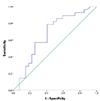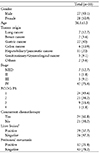Abstract
Background
Serum vitamin B12 has been suggested as one of the cancer diagnostic markers and predictors for survival in cancer patients. In this study, we investigated the relationship between vitamin B12 and tumor progression.
Methods
Solid tumor patients who had serum vitamin B12 levels and radiologic test follow-up were included in the study. A total of 55 patients were included. Receiver operating characteristic analysis was performed to determine the cut-off value of vitamin B12 for tumor progression. Kaplan-Meier method and Cox proportional hazard model for time to progression (TTP) were performed. Subgroup analysis was performed on patients with or without liver lesion (hepatocellular carcinoma and liver metastasis).
Results
The cut-off value of vitamin B12 for tumor progression prediction was 691.4 pg/mL, the sensitivity was 57.1% and the specificity was 59.3%. Patients with vitamin B12≥691.4 pg/mL had shorter median TTP (2.1 months vs. 3.4 months, P=0.011). In subgroup analysis of patients without liver lesion, median TTP was significantly shorter in patients with vitamin B12≥691.4 pg/mL (1.6 months vs. 6.3 months, P=0.021), while there was no significant difference in TTP among the patients with liver lesion. Higher vitamin B12 level (≥691.4 pg/mL) was an independent prognostic factor for tumor progression (adjusted hazard ratio 2.4, 95% confidence interval 1.2–4.8, P=0.019).
Figures and Tables
Figure 1
Progression receiver operating characteristic curve for vitamin B12. 691.4 pg/mL was the cut-off value for serum vitamin B12 level related with tumor progression.

Figure 2
Kaplan-Meier curve for time to progression (TTP). (A) All patients. Median TTP in patients with vitamin B12<691.4 pg/mL and in patients with vitamin B12≥691.4 pg/mL was 3.4 months (95% confidence interval [CI] 1.8–5.0) and 2.1 months (1.9–2.3), respectively (P=0.011). (B) Non-liver lesiona group. Median TTP in patients with vitamin B12<691.4 pg/mL and in patients with vitamin B12≥691.4 pg/mL was 6.3 months (2.9–9.7) and 1.6 months (0.0–3.5), respectively (P=0.021). (C) Liver lesion group. Median TTP in patients with vitamin B12<691.4 pg/mL and in patients with vitamin B12≥691.4 pg/mL was 1.8 months (1.0–2.6) and 2.1 months (2.0–2.3), respectively (P=0.816). P values by log-rank test.
aLiver lesion included hepatocellular carcinoma and liver metastasis.

Table 3
Risk for TTP according to vitamin B12 level

Abbreviations: TTP, time to progression; HR, hazard ratio; CI, confidence interval.
P values by Cox proportional hazard model.
aLiver lesion included hepatocellular carcinoma and liver metastasis.
bAdjusted for age, sex, Eastern Cooperative Oncology Group Performance Status, and concurrent chemotherapy.
References
1. Oh R, Brown DL. Vitamin B12 deficiency. Am Fam Physician. 2003; 67(5):979–986.
2. Lechner K, Födinger M, Grisold W, Püspök A, Sillaber C. Vitamin B12 deficiency. New data on an old them. Wien Klin Wochenschr. 2005; 117(17):579–591.
3. Arendt JF, Nexo E. Cobalamin related parameters and disease patterns in patients with increased serum cobalamin levels. PLoS One. 2012; 7(9):e45979.

4. Arendt JF, Nexo E. Unexpected high plasma cobalamin: proposal for a diagnostic strategy. Clin Chem Lab Med. 2013; 51(3):489–496.
5. Arendt JF, Pedersen L, Nexo E, Sørensen HT. Elevated plasma vitamin B12 levels as a marker for cancer: a population-based cohort study. J Natl Cancer Inst. 2013; 105(23):1799–1805.

6. Arendt JF, Farkas DK, Pedersen L, Nexo E, Sørensen HT. Elevated plasma vitamin B12 levels and cancer prognosis: a population-based cohort study. Cancer Epidemiology. 2016; 40:158–165.

7. Lin CY, Kuo CS, Lu CL, Wu MY, Huang RF. Elevated serum vitamin B(12) levels in association with tumor markers as the prognostic factors predictive for poor survival in patients with hepatocellular carcinoma. Nutr Cancer. 2010; 62(2):190–197.
8. Kelly L, White S, Stone PC. The B12/CRP index as a simple prognostic indicator in patients with advanced cancer: a confirmatory study. Ann Oncol. 2007; 18(8):1395–1399.

9. Eisenhauer EA, Therasse P, Bogaerts J, Schwartz LH, Sargent D, Ford R, et al. New response evaluation criteria in solid tumours: revised RECIST guideline (version 1.1). Eur J Cancer. 2009; 45(2):228–247.

10. Tavares F. Is the B12/CRP index more accurate than you at predicting life expectancy in advanced cancer patients? J Pain Symptom Manage. 2010; 40(1):e12–e13.

11. Ryg J, Nybo M, Hallas J. Cancer incidence in persons with elevated cobalamin levels. Eur J Clin Invest. 2013; 43(6):557–561.

12. Schwettmann L, Berbu S. Reference interval and status for serum folate and serum vitamin B12 in a Norwegian population. Clin Lab. 2015; 61(8):1095–1100.

13. Bor MV, Lydeking-Olsen E, Møller J, Nexø E. A daily intake of approximately 6 microg vitamin B-12 appears to saturate all the vitamin B-12-related variables in Danish postmenopausal women. Am J Clin Nutr. 2006; 83(1):52–58.
14. Salles N, Herrmann F, Sakbani K, Rapin CH, Sieber C. High vitamin B12 level: a strong predictor of mortality in elderly inpatients. J Am Geriatr Soc. 2005; 53(5):917–918.

15. Duffy MJ. Tumor markers in clinical practice: a review focusing on common solid cancers. Med Princ Pract. 2013; 22(1):4–11.

16. Wu AH, Sell S. Markers for hepatocellular carcinoma. Immunol Ser. 1990; 53:403–422.
17. Zhang K, Song P, Gao J, Li G, Zhao X, Zhang S. Perspectives on a combined test of multi serum biomarkers in China: towards screening for and diagnosing hepatocellular carcinoma at an earlier stage. Drug Discov Ther. 2014; 8(3):102–109.

18. Daniele B, Bencivenga A, Megna AS, Tinessa V. Alpha-fetoprotein and ultrasonography screening for hepatocellular carcinoma. Gastroenterology. 2004; 127:5 suppl 1. S108–S112.
19. Farinati F, Marino D, De Giorgio M, Baldan A, Cantarini M, Cursaro C, et al. Diagnostic and prognostic role of alpha-fetoprotein in hepatocellular carcinoma: both or neither? Am J Gastroenterol. 2006; 101(3):524–532.

20. Yu J, Zhang S, Zhao B. Differences and correlation of serum CEA, CA19-9 and CA72-4 in gastric cancer. Mol Clin Oncol. 2016; 4(3):441–449.

21. Du R, Cheng D, Lin L, Sun J, Peng K, Xu Y, et al. Association between serum CA 19-9 and metabolic syndrome: a cross-sectional study. J Diabetes. 2017; 9(11):1040–1047.

22. Virgilio E, Proietti A, D'Urso R, Cardelli P, Giarnieri E, Montagnini M, et al. Measuring intragastric tumor markers in gastric cancer patients: a systematic literature review on significance and reliability. Anticancer Res. 2017; 37(6):2817–2821.

23. Solomon LR. Disorders of cobalamin (vitamin B12) metabolism: emerging concepts in pathophysiology, diagnosis and treatment. Blood Rev. 2007; 21(3):113–130.

24. Collin SM, Metcalfe C, Refsum H, Lewis SJ, Zuccolo L, Smith GD, et al. Circulating folate, vitamin B12, homocysteine, vitamin B12 transport proteins, and risk of prostate cancer: a case-control study, systematic review, and meta-analysis. Cancer Epidemiol Biomarkers Prev. 2010; 19(6):1632–1642.

25. Lildballe DL, Nguyen KQ, Poulsen SS, Nielsen HO, Nexo E. Haptocorrin as marker of disease progression in fibrolamellar hepatocellular carcinoma. Eur J Surg Oncol. 2011; 37(1):72–79.

26. Sysel AM, Valli VE, Nagle RB, Bauer JA. Immunohistochemical quantification of the vitamin B12 transport protein (TCII), cell surface receptor (TCII-R) and Ki-67 in human tumor xenografts. Anticancer Res. 2013; 33(10):4203–4212.
27. Donkena KV, Yuan H, Young CY. Vitamin Bs, one carbon metabolism and prostate cancer. Mini Rev Med Chem. 2010; 10(14):1385–1392.
28. Ermens AA, Vlasveld LT, Lindemans J. Significance of elevated cobalamin (vitamin B12) levels in blood. Clin Biochem. 2003; 36(8):585–590.

29. Fenech MF, Dreosti IE, Rinaldi JR. Folate, vitamin B12, homocysteine status and chromosome damage rate in lymphocytes of older men. Carcinogenesis. 1997; 18(7):1329–1336.

30. Kapiszewska M, Kalemba M, Wojciech , U , Milewicz T. Uracil misincorporation into DNA of leukocytes of young women with positive folate balance depends on plasma vitamin B12 concentrations and methylenetetrahydrofolate reductase polymorphisms. A pilot study. J Nutr Biochem. 2005; 16(8):467–478.




 PDF
PDF ePub
ePub Citation
Citation Print
Print




 XML Download
XML Download